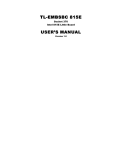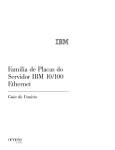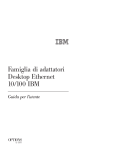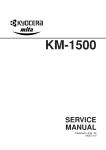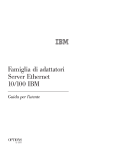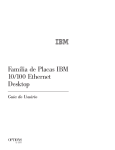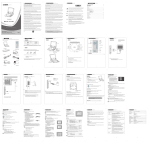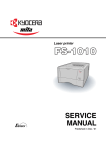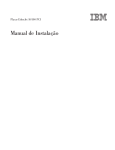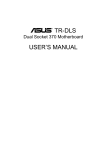Download IB720 USER`S MANUAL
Transcript
IB720 Half-Size Socket 370 CPU Card With VGA/LAN USER’S MANUAL Version 1.0 Acknowledgments Award is a registered trademark of Award Software International, Inc. PS/2 is a trademark of International Business Machines Corporation. Intel and Pentium are registered trademarks of Intel Corporation. Microsoft Windows is a registered trademark of Microsoft Corporation. Winbond is a registered trademark of Winbond Electronics Corporation. All other product names or trademarks are properties of their respective owners. ii IB720 User’s Manual Table of Contents Introduction ..................................................................... 1 Product Description ........................................................1 Checklist ........................................................................2 Specifications .................................................................3 Board Dimensions...........................................................4 Installations...................................................................... 5 Installing the CPU...........................................................6 Installing the Memory (DIMM)........................................7 Setting the Jumpers.........................................................8 Connectors on IB720 .................................................... 14 Watchdog Timer Configuration ...................................... 26 BIOS Setup.....................................................................27 VGA Drivers Installation..............................................49 LAN Drivers Installation..............................................53 Appendix ........................................................................57 A. POST Codes..............................................................................58 B. I/O Port Address Map ..............................................................64 C. Interrupt Request Lines (IRQ)..................................................65 D. Memory Mapping....................................................................66 IB720 User’s Manual iii A Picture of the IB720 CPU Card iv IB720 User’s Manual INTRODUCTION Introduction Product Description IB720 is a high-performance PISA-compliant CPU card that comes with optional VGA and LAN functions. It is based on the Intel 440BX AGPset and features a Socket 370 architecture that supports 66MHz/100MHz front side bus and Intel Celeron / Pentium !!! processors with frequencies up to 850MHz. System memory is provided by one 168-pin DIMM socket that accommodates up to 256MB SDRAM. The on board Award BIOS facilitates easy system configuration and peripheral setup. Other advanced features include DiskOnChip flash disk support, watchdog timer, USB and IrDA interface. DiskOnChip flash disks are storage devices that has no moving parts and emulates FDD/HDD with Flash/RAM/ROM offering reliable data/program storage and long life span. They are reliable and suitable for industrial or other harsh environments characterized by motion, shock, vibration, adverse temperature, dust and humidity. Other features include faster data access, longer MTBF, lower power consumption, cost effective for small capacity and small form factor. IB720 User’s Manual 1 INTRODUCTION Checklist Your IB720 package should include the items listed below. • The IB720 CPU Card • This User’s Man ual • 1 IDE Ribbon Cable • 1 Floppy Ribbon Connector • 2 Serial Port Ribbon Cables and 1 Parallel Port attached to a Mounting Bracket • 1 CD containing the following: • Intel PCI IDE Driver and Flash Memory Utility • VGA Drivers • Ethernet Drivers 2 IB720 User’s Manual INTRODUCTION Specifications Processor Supported Socket 370 processors with CPU frequency up to 850MHz; 66MHz/100MHz Front Side Bus Chipset Intel 440BX AGPset BIOS Award BIOS Supports DMI, PnP System Memory 1x DIMM socket support up to 256MB capacity Multi I/O Chipset Winbond W83977EF (keyboard controller is built-in) I/O Features 1x FDD (up to 2.88MB, 3 Mode, LS120) 1x Parallel Port (EPP, ECP Port) 2x Serial Ports (1x RS232 and 1x RS232/422/485) 1x IrDA TX/RX Headers Bus Master IDE 2x IDE interfaces for up to 4 devices; supports PIO Mode 3/4 or Ultra DMA/33 IDE HDD, and ATAPI CD-ROM VGA (option) C&T 69000 (2MB embedded memory) or C&T 69030 (4MB embedded) VGA controller CRT & LCD panel support Ethernet (option) Intel 82559 Fast Ethernet controller 10/100Mbps data transfer speeds, WakeOnLAN support RJ-45 on board Hardware Monitoring Winbond W83781D IC Monitors CPU/system temperature and voltages SSD Interface Supports M -Systems 2MB~144MB DiskOnChip flash disk USB Pin header for 2 USB ports IrDA Pin header Other Features Watchdog timer Form Factor Half Size, PISA compliant Dimensions 185mm x 127mm (7.29” x 5.0”) Power Requirements +5V : 12A (max); +/-12V : 200mA (max) Operating Temperature 0°C to 60°C Storage Temperature -20°C to 80°C Relative Humidity 10% to 90% (non-condensing) IB720 User’s Manual 3 INTRODUCTION Board Dimensions 4 IB720 User’s Manual INSTALLATIONS Installations This section provides information on how to use the jumpers and connectors on the IB720 in order to set up a workable system. The topics covered are: Installing the CPU...........................................................6 Installing the Memory (DIMM)........................................7 Setting the Jumpers.........................................................8 Connectors on IB720 .................................................... 14 Watchdog Timer Configuration ...................................... 26 IB720 User’s Manual 5 INSTALLATIONS Installing the CPU The IB720 CPU Card supports a Socket 370 processor socket that comes with a lever to secure the processor. Raise this lever to approximately 90° to allow the insertion of the processor. Place the processor into the socket by making sure the notch on the corner of the CPU corresponds with that of the socket. Once the processor has slid into the socket, return the lever to the lock position. After you have installed the processor into the socket, check if the jumpers for the CPU type and speed are correct. Refer to the section on Setting the Jumpers. ? 6 Ensure that the CPU heat sink and the CPU’s top surface are in total contact to avoid CPU overheating problem that would cause your system to hang or be unstable. IB720 User’s Manual INSTALLATIONS Installing the Memory (DIMM) The IB720 CPU Card supports one 168-pin DIMM socket that accommodates a maximum memory of 256MB in SDRAM type. The memory module capacities supported are 32MB, 64MB, 128MB and 256MB. Installing and Removing DIMMs To install the DIMM, locate the memory slot on the CPU card and perform the following steps: 1. Hold the DIMM so that the two keys of the DIMM align with those on the memory slot. 2. Gently push the DIMM in an upright position until the clips of the slot close to hold the DIMM in place when the DIMM touches the bottom of the slot. 3. To remove the DIMM, press the clips with both hands. Lock DIMM Lock Lock Lock Top View of DIMM Socket IB720 User’s Manual 7 INSTALLATIONS Setting the Jumpers Jumpers on IB720 are used to select various settings and features according to your needs and applications. Contact your supplier if you have doubts about the best configuration for your needs. The following lists the connectors on IB720 and their respective functions. Jumper Locations on IB720.........................................................................9 DSW1 (3): CPU Bus Speed Selector..........................................................10 DSW1 (5-8): CPU Frequency Selector ......................................................10 J9, J10: Manufacturing Test Use...............................................................11 J12, J13, J14: RS232/422/485 (COM2) Selection .....................................11 J19: LCD Power Setting.............................................................................11 J26: Watchdog Selection.............................................................................12 J27: DiskOnChip Address Select...............................................................12 J28: Clear CMOS Content .........................................................................12 J29: Onboard LAN Enable/Disable............................................................12 J30: Onboard VGA Enable/Disable............................................................13 The following conventions are used in this section: off off on on Pin 1-2 Short/Closed ↓ ↓ ↑ ↑ 8 IB720 User’s Manual INSTALLATIONS Jumper Locations on IB720 J19: LCD Power Setting J12, J13, J14: RS232/422/485(COM2) Selection J9, J10: Manufacturing Test Use DSW1: CPU Frequency Selector DiskOnChip Socket J26: Watchdog Selection J27: DiskOnChip Address Select J28: Clear CMOS J29: Onboard LAN Enable/Disable J30: Onboard VGA Enable/Disable IB720 User’s Manual 9 INSTALLATIONS DSW1 (3): CPU Bus Speed Selector Bus Speed SW1 (3) Switch Setting 100MHz off 66MHz on DSW1 (5-8): CPU Frequency Selector The table below shows the correct setting to match the CPU frequency. Frequency Multiplier CPU Frequency (66MHz) CPU Frequency (100MHz) 4.5X 300MHz 450MHz SW1(5-8) xx xx xx xx off on off on 5X 333MHz 500MHz xx xx xx xx off off on on 5.5X 366MHz 550MHz xx xx xx xx off off off on 6X 400MHz 600MHz xx xx xx xx on on on off 6.5X 433MHz 650MHz xx xx xx xx on on off off 7X 466MHz 700MHz xx xx xx xx on off on off 7.5X 500MHz 750MHz xx xx xx xx on off off off 8X 533MHz 800MHz xx xx xx xx off on on off 10 IB720 User’s Manual INSTALLATIONS 4 J9, J10: Manufacturing Test Use These two 2-pin header are for manufacturing test use only. COM2 Function Jumper Setting (pin closed) J J 1 J 1 2 1 3 J12, J13, J14: RS232/422/485 (COM2) Selection COM1 is fixed for RS-232 use only. COM2 is selectable for RS232, RS-422 and RS-485. The following table describes the jumper settings for COM2 selection. RS-232 RS-422 RS-485 J12: 1-2 J12: 3-4 J12: 5-6 J13: 3-5 & 4-6 J13: 1-3 & 2-4 J13: 1-3 & 2-4 J14: 3-5 & 4-6 J14: 1-3 & 2-4 J14: 1-3 & 2-4 J19: LCD Power Setting 3.3V Setting 5V Setting IB720 User’s Manual 11 INSTALLATIONS J26: Watchdog Selection J26 Setting Function Pin 1-2 Short/Closed Reset Pin 2-3 Short/Closed NMI J27: DiskOnChip Address Select J27 Address D0000-D7FFF D8000-DFFFF (default) J28: Clear CMOS Content J28 Setting Open Short/Closed Function Normal Operation Clear CMOS Content J29: Onboard LAN Enable/Disable J29 12 Setting LAN Function Pin 1-2 Short/Closed Enabled Pin 2-3 Short/Closed Disabled IB720 User’s Manual INSTALLATIONS J30: Onboard VGA Enable/Disable J30 Setting VGA Function Pin 1-2 Short/Closed Enabled Pin 2-3 Short/Closed Disabled IB720 User’s Manual 13 INSTALLATIONS [ Connectors on IB720 The connectors on IB720 allows you to connect external devices such as keyboard, floppy disk drives, hard disk drives, printers, etc. The following table lists the connectors on IB720 and their respective functions. Connector Locations on IB720 ..................................................................15 P1: AT P8 Power Connector .....................................................................16 J1: System Fan Power Connector..............................................................16 J2: CPU Fan Power Connector..................................................................16 J3, J11: EIDE Connectors..........................................................................17 J4: Floppy Drive Connector......................................................................18 J5: Parallel Port Connector.........................................................................18 J6: System Function Connector.................................................................19 J7, J8: COM2, COM1 Serial Port .............................................................21 J15, J16: USB Connectors .........................................................................21 J17: PS/2 Keyboard Connector..................................................................22 J18: LCD Panel Connector.........................................................................22 Flat Panel Display Interface Pin Descriptions...........................................23 J20: IrDA Connector..................................................................................23 J21: External PS/2 Mouse Connector.........................................................24 J22: PS/2 Mouse Connector.......................................................................24 J23: WakeOnLAN Connector....................................................................24 J24: VGA CRT Connector.........................................................................25 J25: RJ45 Connector..................................................................................25 J31: ATX Power Controller Connector.....................................................25 J32: External Keyboard Connector ............................................................25 14 IB720 User’s Manual INSTALLATIONS Connector Locations on IB720 1 2 7 3 5 4 6 8 9 10 11 12 13 DiskOnChip Socket 20 19 18 16 17 1 2 3/4 5 6 7 8 9/10 11 12 13 14 15 16 17 18 19 20 21 21 15 14 J1: System Fan Power Connector J2: CPU Fan Power Connector J3, J11: EIDE Connectors J4: Floppy Drive Connector J5: Parallel Port Connector J6: System Function Connector J15, J16: USB Connectors J7, J8: COM2, COM1 Serial Port J17: PS/2 Keyboard Connector J22: PS/2 Mouse Connector J24: VGA CRT Connector J32: External Keyboard Connector J25: RJ45 Connector J21: External PS/2 Mouse Connector J20: IrDA Connector J23: WakeOnLAN Connector J18: LCD Panel Connector P1: AT P8 Power Connector J31: ATX Power Controller Connector IB720 User’s Manual 15 INSTALLATIONS P1: AT P8 Power Connector 1 6 Pin # 1 2 3 4 5 6 Signal Name N.C. +5V +12V -12V Ground Ground J1: System Fan Power Connector J1 is a 3-pin header for the system fan. The fan must be a 12V fan. 1 2 3 Pin # 1 2 3 Signal Name Rotation +12V Ground J2: CPU Fan Power Connector J2 is a 3-pin header for the CPU fan. The fan must be a 12V fan. 1 2 3 16 Pin # 1 2 3 Signal Name Rotation +12V Ground IB720 User’s Manual INSTALLATIONS J3, J11: EIDE Connectors J3 J11 J3: Primary IDE Connector Signal Name Pin # Reset IDE 1 Host data 7 3 Host data 6 5 Host data 5 7 Host data 4 9 Host data 3 11 Host data 2 13 Host data 1 15 Host data 0 17 Ground 19 DRQ0 21 Host IOW 23 Host IOR 25 IOCHRDY 27 DACK0 29 IRQ14 31 Address 1 33 Address 0 35 Chip select 0 37 Activity 39 Pin # 2 4 6 8 10 12 14 16 18 20 22 24 26 28 30 32 34 36 38 40 Signal Name Ground Host data 8 Host data 9 Host data 10 Host data 11 Host data 12 Host data 13 Host data 14 Host data 15 Key Ground Ground Ground Host ALE Ground No connect No connect Address 2 Chip select 1 Ground J11: Secondary IDE Connector Signal Name Pin # Pin # Reset IDE 1 2 Host data 7 3 4 Host data 6 5 6 Host data 5 7 8 Host data 4 9 10 Host data 3 11 12 Host data 2 13 14 Host data 1 15 16 Host data 0 17 18 Ground 19 20 DRQ1 21 22 Host IOW 23 24 Host IOR 25 26 IOCHRDY 27 28 DACK1 29 30 IRQ15 31 32 Address 1 33 34 Address 0 35 36 Chip select 0 37 38 Activity 39 40 Signal Name Ground Host data 8 Host data 9 Host data 10 Host data 11 Host data 12 Host data 13 Host data 14 Host data 15 Key Ground Ground Ground Host ALE Ground No connect No connect Address 2 Chip select 1 Ground IB720 User’s Manual 17 INSTALLATIONS J4: Floppy Drive Connector J4 Signal Name Ground Ground Ground Ground Ground Ground Ground Ground Ground Ground Ground Ground Ground Ground Ground Ground Ground Pin # 1 3 5 7 9 11 13 15 17 19 21 23 25 27 29 31 33 Pin # 2 4 6 8 10 12 14 16 18 20 22 24 26 28 30 32 34 Signal Name RM/LC No connect No connect Index Motor enable 0 Drive select 1 Drive select 0 Motor enable 1 Direction Step Write data Write gate Track 00 Write protect Read data Side 1 select Diskette change J5: Parallel Port Connector The following table describes the pin out assignments of this connector. J5 18 Signal Name Line printer strobe PD0, parallel data 0 PD1, parallel data 1 PD2, parallel data 2 PD3, parallel data 3 PD4, parallel data 4 PD5, parallel data 5 PD6, parallel data 6 PD7, parallel data 7 ACK, acknowledge Busy Paper empty Select Pin # 1 2 3 4 5 6 7 8 9 10 11 12 13 Pin # 14 15 16 17 18 19 20 21 22 23 24 25 N/A IB720 User’s Manual Signal Name AutoFeed Error Initialize Select Ground Ground Ground Ground Ground Ground Ground Ground N/A INSTALLATIONS J6: System Function Connector J6 provides connectors for system indicators that provide light indication of the computer activities and switches to change system status. J6 is a 20-pin header that provides interfaces for the following functions. Hard Disk Drive LED Reset Switch Turbo LED Connector ATX Power On Switch SMI / Hardware Switch Power LED and Keylock Speaker Speaker: Pins 1 - 4 This connector provides an interface to a speaker for audio tone generation. An 8-ohm speaker is recommended. Pin # 1 2 3 4 Signal Name Speaker out No connect Ground +5V Power LED and Keylock: Pins 11 - 15 The power LED indicates the status of the main power switch. The keylock switch, when closed, will disable the keyboard function. Pin # 11 12 13 14 15 IB720 User’s Manual Signal Name Power LED No connect Ground Keylock Ground 19 INSTALLATIONS SMI/Hardware Switch: Pins 6 and 16 This connector supports the "Green Switch" on the control panel, which, when pressed, will force the system into the power-saving mode immediately. Pin # 6 16 Signal Name Sleep Ground ATX Power ON Switch: Pins 7 and 17 This 2-pin connector is an “ATX Power Supply On/Off Switch” on the system that connects to the power switch on the case. When pressed, the power switch will force the system to power on. When pressed again, it will force the system to power off. Turbo LED Connector: Pins 8 and 18 There is no turbo/deturbo function on the CPU card. The Turbo LED on the control panel will always be On when attached to this connector. Pin # 8 18 Signal Name 5V Ground Reset Switch: Pins 9 and 19 The reset switch allows the user to reset the system without turning the main power switch off and then on again. Orientation is not required when making a connection to this header. 20 IB720 User’s Manual INSTALLATIONS Hard Disk Drive LED Connector: Pins 10 and 20 This connector connects to the hard drive activity LED on control panel. This LED will flash when the HDD is being accessed. Pin # 10 20 Signal Name Ground 5V J7, J8: COM2, COM1 Serial Port J7 and J8, both 10-pin headers, are the onboard serial port connectors of the IB720. The following table shows the pin assignments of these connectors. . J8: COM1 J7: COM2 Pin # Signal Name 1 2 3 4 5 6 7 8 9 10 DCD, Data carrier detect RXD, Receive data TXD, Transmit data DTR, Data terminal ready GND, ground DSR, Data set ready RTS, Request to send CTS, Clear to send RI, Ring indicator NC J15, J16: USB Connectors These are the pin headers for the optional USB cable connector. J16 1 2 3 4 J15 USB 1 2 3 4 J16 Pin # 1 2 3 4 J15 Pin # 1 2 3 4 IB720 User’s Manual Signal Name Vcc USBUSB+ Ground 21 INSTALLATIONS J17: PS/2 Keyboard Connector Pin # 1 2 3 4 5 6 J17 Signal Name Keyboard data N.C. GND 5V Keyboard clock N.C. J18: LCD Panel Connector Use J18 to connect the system to an LCD panel. 50 49 2 J18 1 22 Signal Name GND P34 P35 P30 P29 P25 P24 P23 P16 P17 P19 P13 P15 P7 5V or 3.3V P9 P4 P3 P2 M SHFCLK FPVDD FPVEE GND +12V Pin # 1 3 5 7 9 11 13 15 17 19 21 23 25 27 29 31 33 35 37 39 41 43 45 47 49 IB720 User’s Manual Pin # 2 4 6 8 10 12 14 16 18 20 22 24 26 28 30 32 34 36 38 40 42 44 46 48 50 Signal Name P33 P31 P32 P28 P27 P26 P21 P22 P20 P18 P14 P12 P11 P10 5V or 3.3V P8 P6 P5 P1 P0 ENABKL FLM(V SYNC) LP(H SYNC) GND +12V INSTALLATIONS Flat Panel Display Interface Pin Descriptions Pin Name P0 P1 P2 P3 P4 P5 P6 P7 P8 P9 P10 P11 P12 P13 P14 P15 P16 P17 P18 P19 P20 P21 P22 P23 P24 P25 P26 P27 P28 P29 P30 P31 P32 P33 P34 P35 SHFCLK Pixels/Clk: Mono Mono Mono Color Color Color Color Color Color Color Color Color SS DD DD TFT TFT TFT TFT TFT+HR STN-SS STN-SS STN-DD STN-DD 8-bit 8-bit 16-bit 9/12/16 18/24 36-bit 18/24 8-bit 16-bit 8-bit 16-bit 24-bit bit bit bit (4bP) (4bP) (4bP) (4bP) D0 UD3 UD7 B0 B0 FB0 FB0 R1 R1 UR1 UR0 UR0 D1 UD2 UD6 B1 B1 FB1 FB1 B1 G1 UG1 UG0 UG0 D2 UD1 UD5 B2 B2 FB2 FB2 G2 B1 UB1 UB0 UB0 D3 UD0 UD4 B3 B3 FB3 FB3 B3 R2 UB2 UR1 LR0 D4 LD3 UD3 B4 B4 FB4 SB0 G4 G3 LR1 LR0 LG0 D5 LD2 UD2 G0 B5 FB5 SB1 R5 B2 LG1 LG0 LB0 D6 LD1 UD1 G1 B6 SB0 SB2 B5 R3 LB1 LB0 UR1 D7 LD0 UD0 G2 B7 SB1 B3 G3 LR2 LR1 UG1 LD7 G3 G0 SB2 FG0 B3 UG1 UB1 LD6 G4 G1 SB3 FG1 R4 UB1 LR1 LD5 G5 G2 SB4 FG2 G4 UR2 LG1 LD4 R0 G3 SB5 FG3 B4 UG2 LB1 LD3 R1 G4 FG0 SG0 R5 LG1 UR2 LD2 R2 G5 FG1 SG1 G5 LB1 UG2 LD1 R3 G6 FG2 SG2 B5 LR2 UB2 LD0 R4 G7 FG3 SG3 G6 LG2 LR2 R0 FG4 FR0 LG2 R1 FG5 FR1 LB2 R2 SG0 FR2 UR3 R3 SG1 FR3 UG3 R4 SG2 SR0 LR3 R5 SG3 SR1 LG3 R6 SG4 SR2 LB3 R7 SG5 SR3 FR0 FR1 FR2 FR3 FR4 FR5 SR0 SR1 SR2 SR3 SR4 SR5 SHFCL K SHFCL K SHFCL K SHFCLK SHFCL K SHFCL K SHFCL K SHFCLK SHFCLK SHFCLK SHFCLK SHFCLK 8 8 16 1 1 2 2 2-2/3 5-1/3 2-2/3 5-1/3 8 P24 J20: IrDA Connector J20 is used for an IrDA connector for wireless communication. +5V IRTX IRRX N.C. GND Pin # 1 2 3 4 5 Signal Name +5V No connect Ir TX Ground Ir RX IB720 User’s Manual 23 INSTALLATIONS J21: External PS/2 Mouse Connector J21 is a 5-pin pin header for the optional external PS/2 mouse cable connector. M. Data Gnd M. Clk N.C. 5V Pin # 1 2 3 4 5 Signal Name Mouse data N.C. Ground 5V Mouse Clock J22: PS/2 Mouse Connector J22 Pin # 1 2 3 4 5 6 Signal Name Mouse data N.C. N.C. 5V Mouse Clock N.C. J23: WakeOnLAN Connector The table below shows the pin out assignments J23. WakeOnLAN will function properly only with an ATX power supply with 5VSB that has 800mA. 1 2 3 24 Pin # 1 2 3 Signal Name +5VSB Ground Wake on LAN IB720 User’s Manual INSTALLATIONS J24: VGA CRT Connector The pin assignments of the VGA CRT connector are as follows: Signal Name Red Blue GND GND N.C. N.C. HSYNC NC J24 Pin 1 3 5 7 9 11 13 15 Pin 2 4 6 8 10 12 14 Signal Name Green N.C. GND GND GND N.C. VSYNC J25: RJ45 Connector This connector is for the Ethernet function of the CPU card. The figure below shows the pin out assignments of this connector and its corresponding input jack. TD+(pin#1) T D-(pin#2) RD+(pin#3) Active LED RD-(pin#6) 10M/100M LED J25 J31: ATX Power Controller Connector Pin # 1 2 3 1 2 3 Signal Name Ground PS-ON (soft on/of) 5VSB (Standby +5V) J32: External Keyboard Connector 1 5 Pin # 1 2 3 4 5 Signal Name Keyboard clock Keyboard data NC GND Vcc IB720 User’s Manual 25 INSTALLATIONS Watchdog Timer Configuration The function of the watchdog timer is to reset the system automatically and is defined at I/O port 0443H. To enable the watchdog timer and allow the system to reset, write I/O port 0443H. To disable the timer, write I/O port 0441H for the system to stop the watchdog function. The timer has a tolerance of 20% for its intervals. The following describes how the timer should be programmed. Enabling Watchdog: MOV AX, 000FH (Choose the values from 0) MOV DX, 0443H OUT DX, AX Disabling Watchdog MOV AX, 00FH (Any value is fine.) MOV DX, 0441H OUT DX, AX WATCHDOG TIMER CONTROL TABLE Level 1 2 3 4 5 6 7 8 26 Value F E D C B A 9 8 Time/sec 0 2 4 6 8 10 12 14 Level 9 10 11 12 13 14 15 16 IB720 User’s Manual Value 7 6 5 4 3 2 1 0 Time/sec 16 18 20 22 24 26 28 30 BIOS SETUP BIOS Setup This chapter describes the different settings available in the Award BIOS that comes with the CPU card. The topics covered in this chapter are as follows: BIOS Introduction......................................................................................28 BIOS Setup ................................................................................................28 Standard CMOS Setup...............................................................................30 BIOS Features Setup..................................................................................33 Power Management Setup .........................................................................39 PNP/PCI Configuration..............................................................................42 Load BIOS Defaults...................................................................................43 Integrated Peripherals.................................................................................44 Supervisor / User Password.......................................................................46 IDE HDD Auto Detection.........................................................................47 Save & Exit Setup.......................................................................................48 Exit Without Saving....................................................................................48 IB720 User’s Manual 27 BIOS SETUP BIOS Introduction The Award BIOS (Basic Input/Output System) installed in your computer system’s ROM supports Intel processors in a standard IBM -AT compatible I/O system. The BIOS provides critical low-level support for a standard device such as disk drives, serial ports and parallel ports. It also adds virus and password protection as well as special support for detailed fine-tuning of the chipset controlling the entire system. BIOS Setup The Award BIOS provides a Setup utility program for specifying the system configurations and settings. The BIOS ROM of the system stores the Setup utility. When you turn on the computer, the Award BIOS is immediately activated. Pressing the <Del> key immediately allows you to enter the Setup utility. If you are a little bit late pressing the <Del> key, POST (Power On Self Test) will continue with its test routines, thus preventing you from invoking the Setup. If you still wish to enter Setup, restart the system by pressing the ”Reset” button or simultaneously pressing the <Ctrl>, <Alt> and <Delete> keys. You can also restart by turning the system Off and back On again. The following message will appear on the screen: Press <DEL> to Enter Setup In general, you press the arrow keys to highlight items, <Enter> to select, the <PgUp> and <PgDn> keys to change entries, <F1> for help and <Esc> to quit. When you enter the Setup utility, the Main Menu screen will appear on the screen. The Main Menu allows you to select from various setup functions and exit choices. 28 IB720 User’s Manual BIOS SETUP ROM PCI/ISA BIOS CMOS SETUP UTILITY AWARD SOFTWARE, INC. STANDARD CMOS SETUP BIOS FEATURES SETUP CHIPSET FEATURES SETUP POWER MANAGEMENT SETUP PNP/PCI CONFIGURATION LOAD BIOS DEFAULTS LOAD SETUP DEFAULTS INTEGRATED PERIPHERALS SUPERVISOR PASSWORD USER PASSWORD IDE HDD AUTO DETECTION SAVE & EXIT SETUP EXIT WITHOUT SAVING ESC : Quit F10 : Save & Exit Setup á â à ß : Select Item (Shift) F2 : Change Color Time, Date, Hard Disk Type The section below the setup items of the Main Menu displays the control keys for this menu. At the bottom of the Main Menu just below the control keys section, there is another section which displays information on the currently highlighted item in the list. ? If your computer cannot boot after making and saving system changes with Setup, the Award BIOS supports an override to the CMOS settings that resets your system to its default. Warning: It is strongly recommended that you avoid making any changes to the chipset defaults. These defaults have been carefully chosen by both Award and your system manufacturer to provide the absolute maximum performance and reliability. Changing the defaults could cause the system to become unstable and crash in some cases. IB720 User’s Manual 29 BIOS SETUP Standard CMOS Setup The “Standard CMOS Setup” choice allows you to record some basic hardware configurations in your computer system and set the system clock and error handling. If the card is already installed in a working system, you will not need to select this option. You will need to run the Standard CMOS option, however, if you change your system hardware configurations, the onboard battery fails, or the configuration stored in the CMOS memory was lost or damaged. ROM PCI/ISA BIOS STANDARD CMOS SETUP AWARD SOFTWARE, INC. Date (mm:dd:yy) : Wed, Mar 4 1998 Time (hh:mm:ss) : 00 : 00 : 00 HARD DISKS TYPE SIZE CYLS HEAD PRECOMP LANDZ SECTOR MODE Primary Master Primary Slave Auto 0 0 0 0 0 0 Auto Auto 0 0 0 0 0 0 Auto Secondary Master Auto 0 0 0 0 0 0 Auto Secondary Slave Auto 0 0 0 0 0 0 Auto Drive A Drive B : 1.44M, 3.5in : None Video Halt On : EGA / VGA : All Errors ESC : Quit F1 : Help Base Memory Extended Memory Other Memory : : : 640K 15360K 384K Total Memory : 16384K á â à ß : Select Item (Shift) F2 : Change Color PU / PD / + / - : Modify At the bottom of the menu are the control keys for use on this menu. If you need any help in each item field, you can press the <F1> key. It will display the relevant information to help you. The memory display at the lower right-hand side of the menu is read-only. It will adjust automatically according to the memory changed. The following describes each item of this menu. Date The date format is: Day : Month : Date : Year : Sun to Sat 1 to 12 1 to 31 1994 to 2079 To set the date, highlight the “Date” field and use the PageUp/ PageDown or +/keys to set the current time. 30 IB720 User’s Manual BIOS SETUP Time The time format is: Hour : 00 to 23 Minute : 00 to 59 Second : 00 to 59 To set the time, highlight the “Time” field and use the <PgUp>/ <PgDn> or +/keys to set the current time. Primary HDDs / Secondary HDDs The onboard PCI IDE connectors provide Primary and Secondary channels for connecting up to four IDE hard disks or other IDE devices. Each channel can support up to two hard disks; the first is the “Master” and the second is the “Slave”. To enter the specifications for a hard disk drive, you must select first a “Type”. There are 45 predefined types and 4 user definable types are for Enhanced IDE BIOS. Type 1 to 45 are predefined. Type “User” is user-definable. For the Primary Master/Slave as well as Secondary Master/Slave, you can select “Auto” under the TYPE and MODE fields. This will enable auto detection of your IDE drives and CD-ROM drive during POST. Press <PgUp>/<PgDn> to select a numbered hard disk type or type the number and press the <Enter> key. The hard disk will not work properly if you enter incorrect information for this field. If your hard disk drive type is not matched or listed, you can use Type User to define your own drive type manually. If you select Type User, related information is asked to be entered to the following items. CYLS : Number of cylinders HEAD : Number of read/write heads PRECOMP : Write precompensation LANDZ : Landing zone SECTOR : Number of sectors SIZE : Automatically adjust according to the configuration MODE (for IDE HDD only) : Auto Normal (HD < 528MB) Large (for MS-DOS only) LBA (HD > 528MB and supports Logical Block Addressing) IB720 User’s Manual 31 BIOS SETUP ? The specifications of your drive must match with the drive table. The hard disk will not work properly if you enter incorrect information in these fields. If your hard disk drive type is not matched or listed, you can use Type User to define your own drive type manually. Drive A / Drive B These fields identify the types of floppy disk drive A or drive B that has been installed in the computer. The available specifications are: 360KB 2MB 720KB 44MB 88MB 5.25 in. 5.25 in. 3.5 in. 3.5 in. 3.5 in. Video This field selects the type of video display card installed in your system. You can choose the following video display cards: EGA/VGA For EGA, VGA, SEGA, SVGA or PGA monitor adapters. (default) CGA 40 Power up in 40 column mode. CGA 80 Power up in 80 column mode. MONO For Hercules or MDA adapters. Halt On This field determines whether the system will halt if an error is detected during power up. No errors The system boot will not be halted for any error that may be detected. (default) All errors Whenever the BIOS detects a non-fatal error, the system will stop and you will be prompted. All, But Keyboard The system boot will not be halted for a keyboard error; it will stop for all other errors All, But Diskette The system boot will not be halted for a disk error; it will stop for all other errors. All, But Disk/Key The system boot will not be halted for a key- board or disk error; it will stop for all others. 32 IB720 User’s Manual BIOS SETUP BIOS Features Setup This section allows you to configure and improve your system and allows you to set up some system features according to your preference. ROM / PCI ISA BIOS BIOS FEATURES SETUP AWARD SOFTWARE, INC. Virus Warning CPU Internal Cache External Cache CPU L2 Cache ECC Checking Processor Number Feature Quick Power On Self Test Boot Sequence Swap Floppy Drive Boot Up Numlock Status Gate A20 Option Typematic Rate Setting Typematic Rate (chars/Sec) Typematic Delay (Msec) Security Option PCI /VGA Palette Snoop : Disabled : Enabled : Enabled : Disabled : Enabled : Enabled : A, C, SCSI : Disabled : On : Fast : Disabled :6 : 250 : Setup : Disabled Video BIOS Shadow C8000-CBFFF Shadow CC000-CFFFF Shadow D0000-D3FFF Shadow D4000-D7FFF Shadow D8000-DBFFF Shadow DC000-DFFF Shadow : Enabled : Disabled : Disabled : Disabled : Disabled : Disabled : Disabled OS Select For DRAM>64MB HDD S.M.A.R.T. Capability Report No FDD For WIN 95 : Non-OS2 : Disabled : Yes ESC : Quit á â à ß : Select Item F1 : Help PU/PD/+/- : Modify F5 : Old Values (Shift) F2 : Color F6 : Load BIOS Defaults F7 : Load Setup Defaults Virus Warning This item protects the boot sector and partition table of your hard disk against accidental modifications. If an attempt is made, the BIOS will halt the system and display a warning message. If this occurs, you can either allow the operation to continue or run an anti-virus program. CPU Internal Cache / External Cache When the CPU requests data, the system transfers the requested data from the main DRAM into cache memory, for even faster access by the CPU. These items allow you to enable (speed up memory access) or disable the cache function. By default, these items are Enabled. CPU L2 Cache ECC Checking When enabled, this allows ECC checking of the CPU’s L2 cache. Processor Number Feature This field only appears if the processor on board is a Pentium III processor. The Processor Number Feature can be enabled or disabled. IB720 User’s Manual 33 BIOS SETUP Quick Power On Self Test When enabled, this field speeds up the Power On Self Test (POST) after the system is turned on. If it is set to Enabled, BIOS will skip some items. Boot Sequence This field determines the drive that the system searches first for an operating system. The options are: A, C, SCSI D, A, SCSI SCSI, C, A C, A, SCSI E, A, SCSI C only C, CDROM, A F, A, SCSI LS/ZIP, C CDROM, C, A SCSI, A, C The default value is A, C, SCSI. Swap Floppy Drive This item allows you to determine whether or not to enable Swap Floppy Drive. When enabled, the BIOS swaps floppy drive assignments so that Drive A becomes Drive B, and Drive B becomes Drive A. By default, this field is set to Disabled. Boot Up Floppy Seek When enabled, the BIOS will seek whether or not the floppy drive installed has 40 or 80 tracks. 360K type has 40 tracks while 760K, 1.2M and 1.44M all have 80 tracks. By default, this field is set to Enabled. Boot Up NumLock Status This allows you to activate the NumLock function after you power up the system. By default, the system boots up with NumLock On. Boot Up System Speed This has no function and selects the default system speed (High). Gate A20 Option This field allows you to select how Gate A20 is worked. Gate A20 is a device used to address memory above 1 MB. The default setting is Fast. Typematic Rate Setting When disabled, continually holding down a key on your keyboard will generate only one instance. When enabled, you can set the two typematic controls listed next. By default, this field is set to Disabled. 34 IB720 User’s Manual BIOS SETUP Typematic Rate (Chars/Sec) When the typematic rate is enabled, the system registers repeated keystrokes speeds. You can select speed range from 6 to 30 characters per second. By default, this item is set to 6. Typematic Delay (Msec) When the typematic rate is enabled, this item allows you to set the time interval for displaying the first and second characters. Security Option This field allows you to limit access to the System and Setup. The default value is Setup. When you select System, the system prompts for the User Password every time you boot up. When you selectSetup, the system always boots up and prompts for the Supervisor Password only when the Setup utility is called up. PCI/VGA Palette Snoop Some non-standard VGA display cards may not show colors properly. This field allows you to set whether or not MPEG ISA/VESA VGA Cards can work with PCI/VGA. When this field is enabled, a PCI/VGA can work with an MPEG ISA/VESA VGA card. When this field is disabled, a PCI/VGA cannot work with an MPEG ISA/VESA Card. OS Select for DRAM > 64MB This option allows the system to access greater than 64MB of DRAM memory when used with OS/2 that depends on certain BIOS calls to access memory. The default setting is Non-OS/2. Report No FDD for Win 95 This option allows Windows 95 to share with other peripherals IRQ6 which is assigned to a floppy disk drive if the drive is not existing. HDD S.M.A.R.T. Capability Enable this field if S.M.A.R.T. is supported by the HDD installed. Video BIOS Shadow This item allows you to change the Video BIOS location from ROM to RAM. Video Shadow will increase the video speed. C8000 - CBFFF Shadow/DC000 - DFFFF Shadow Shadowing a ROM reduces the memory available between 640KB to 1024KB. These fields determine whether or not optional ROM will be copied to RAM. IB720 User’s Manual 35 BIOS SETUP Chipset Features Setup This Setup menu controls the configuration of the chipset. ROM PCI/ISA BIOS CHIPSET FEATURES SETUP AWARD SOFTWARE INC. SDRAM RAS-to-CAS Delay SDRAM RAS Precharge Time SDRAM CAS Latency Time SDRAM Precharge Control DRAM Data Integrity Mode System BIOS Cacheable Video BIOS Cacheable Video RAM Cacheable 8 Bit I/O Recovery Time 16 Bit I/O Recovery Time Memory Hole At 15MB-16MB Passive Release Delayed Transaction : : : : : : : : : : : : : 3 3 3 Disabled Non-ECC Disabled Disabled Disabled 3 2 Disabled Enabled Enabled CPU Warning Temperature : 66°C/151°F Current System Temp. Current CPU Temp. : 41°C/ 105°F : 27°C/ 80°F Current CPU Fan Speed : 2789 RPM Current Chassis Fan Speed : 2045 RPM VCCP (V) : 1.98 V VTT (V) : 1.50 V VCC3 (V) : 3.45 V +5V : 4.99 V +12 V : 12.46 V -12 V : -12.54V -5V : - 5.21 V ESC : Quit á â à ß : Select Item F1 : Help PU/PD/+/- : Modify F5 : Old Values (Shift) F2 : Color F6 : Load BIOS Defaults F7 : Load Setup Defaults SDRAM RAS-to-CAS Delay When DRAM is refreshed, both rows and columns are addressed separately. This field allows you to determine the timing of transition from Row Address Strove (RAS) to Column Address Strobe (CAS). The default setting is 3. SDRAM RAS Precharge Time The precharge time is the number of cycles it takes for the RAS to accumulate its charge before DRAM refresh. If insufficient time is allowed, refresh may be incomplete and the DRAM may fail to retain data. The default setting is 3. SDRAM CAS Latency Time When synchronous DRAM is installed, the number of clock cycles of CAS latency depends on the DRAM timing. Do not reset this field from the default value specified by the system designer. The default value is 3. SDRAM Precharge Control By default, the SDRAM Precharge Control field is set to Disabled. System BIOS Cacheable When enabled, access to the system BIOS ROM addressed at F0000H-FFFFFH is cached, provided that the cache controller is disabled. 36 IB720 User’s Manual BIOS SETUP DRAM Data Integrity Mode This field configures your RAM's data integrity mode. ECC stands for Error Checking and Correction and it should only be used if you are using special 72-bit ECC RAM. This will enable the system to detect and correct single-bit errors. It will also detect double-bit errors though it will not correct them. Video RAM Cacheable Selecting Enabled allows caching of the video BIOS ROM at C0000h to C7FFFh, resulting in better video performance. If any program writes to this memory area, a memory access error may result. System BIOS Cacheable This feature is only valid when the system BIOS is shadowed. It enables or disables the caching of the system BIOS ROM at F0000h-FFFFFh via the L2 cache. This greatly speeds up accesses to the system BIOS. However, this does not translate into better system performance because the OS does not need to access the system BIOS much. Video BIOS Cacheable This feature is only valid when the video BIOS is shadowed. It enables or disables the caching of the video BIOS ROM at C0000h-C7FFFh via the L2 cache. This greatly speeds up accesses to the video BIOS. However, this does not translate into better system performance because the OS bypasses the BIOS using the graphics driver to access the video card's hardware directly. 8 Bit I/O Recovery Time This option specifies the length of the delay (in sysclks) inserted between consecutive 8-bit I/O operations. The settings are 1, 2, 3, 4, 5, 6, 7, and 8. The default setting is 3. 16 Bit I/O Recovery Time This option specifies the length of the delay (in sysclks) inserted between consecutive 16-bit I/O operations. The settings are 1, 2, 3, and 4. The default setting is 2. Memory Hole at 15MB - 16MB In order to improve performance, certain space in memory can be reserved for ISA cards. This field allows you to reserve 15MB to 16MB of memory address space to ISA expansion cards. This makes memory from 15MB and up unavailable to the system. Expansion cards can only access memory up to 16MB. By default, this field is set to Disabled. IB720 User’s Manual 37 BIOS SETUP Passive Release When enabled, CPU to PCI bus accesses are allowed during passive release. Otherwise, the arbiter only accepts another PCI master access to local DRAM. Delayed Transaction The chipset has an embedded 32-bit posted write buffer to support delay transactions cycles. Select Enabled to support compliance with PCI specification version 2.1. The default setting is Disabled. Auto Detect DIMM/PCI Clk When enabled, the system automatically shuts off clocks of unused DIMM/PCI slots. The default setting is Disabled. This field is for CE testing use only. Spread Spectrum This field sets the value of the spread spectrum. Options are Disabled, 0.25% and 0.5%. The default setting is Disabled. This field is for CE testing use only . CPU Warning Temperature This field sets the threshold temperature at which an alert is sounded through the system’s speaker. The CPU temperature is monitored by the onboard thermal sensor to prevent the CPU from overheating. Current System Temp./ Current CPU Temp. These read-only fields reflect the functions of the hardware thermal sensor that monitors the chip blocks and system temperatures to ensure the system is stable. Current CPU Fan Speed/Chassis Fan Speed These optional and read-only fields show the current speeds in RPM (revolution per minute) for the CPU fan and chassis fan as monitored by the hardware monitoring IC. VCCP / VTT / VCC3 These optional and read-only fields show the current voltages in the voltage regulators and power supply as monitored by the hardware monitoring IC. 38 IB720 User’s Manual BIOS SETUP Power Management Setup The Power Management Setup allows you to save energy of your system effectively. It will shut down the hard disk and turn off video display after a period of inactivity. ROM PCI/ISA BIOS POWER MANAGEMENT SETUP AWARD SOFTWARE, INC. Power Management PM Control by APM Video Off Method Video Off After MODEM Use IRQ : User Define : Yes : V/H SYNC +Blank : Standby :3 Doze Mode Standby Mode Suspend Mode HDD Power Down Throttle Duty Cycle PCI VGA Active Monitor Soft-Off by PWR-BTTN Power On by Ring : Disabled : Disabled : Disabled : Disabled : 62.5% : Disabled : Instant-Off : Disabled IRQ 8 Break Suspend : Disabled ** Reload Global Timer Events ** IRQ3 (3-7, 9-15), NMI : Disabled Primary IDE 0 : Enabled Primary IDE 1 : Enabled Secondary IDE 0 : Disabled Secondary IDE 1 : Disabled Floppy Disk : Disabled Serial Port : Enabled Parallel Port : Disabled ESC : Quit á â à ß : Select Item F1 : Help PU/PD/+/- : Modify F5 : Old Values (Shift) F2 : Color F6 : Load BIOS Defaults F7 : Load Setup Defaults Power Management This field allows you to select the type of power saving management modes. There are four selections for Power Management. Min. Power Saving Minimum power management Max. Power Saving Maximum power management. User Define Each of the ranges is from 1 min. to 1hr. Except for HDD Power Down which ranges from 1 min. to 15 min. (Default) NOTE: In order to enable the CPU overheat protection feature, the Power Management field should not be set to Disabled. IB720 User’s Manual 39 BIOS SETUP PM Control by APM This field allows you to use the Advanced Power Management device to enhance the Max. Power Saving mode and stop the CPU’s internal clock. If the Max. Power Saving is not enabled, this will be preset to NO. Video Off Method This field defines the Video Off features. There are three options. V/H SYNC + Blank Default setting, blank the screen and turn off vertical and horizontal scanning. DPMS Allows the BIOS to control the video display card if it supports the DPMS feature. Blank Screen This option only writes blanks to the video buffer. Video Off After As the system moves from lesser to greater power-saving modes, select the mode in which you want the monitor to blank. Modem Use IRQ This field names the interrupt request (IRQ) line assigned to the modem (if any) on your system. Activity of the selected IRQ always awakens the system. By default, the IRQ is set to 3. Doze Mode When enabled, and after the set time of system inactivity, the CPU clock will run at a slower speed while all other devices still operate at full speed. Standby Mode After the selected period of system inactivity, the fixed disk drive and the video shut off while all other devices still operate at full speed. Suspend Mode When enabled, and after the set time of system inactivity, all devices except the CPU will be shut off. HDD Power Down When enabled, and after the set time of system inactivity, the hard disk drive will be powered down while all other devices remain active. Throttle Duty Cycle When the system enters Doze mode, the CPU clock runs only part of the time. You may select the percent of time that the clock runs. 40 IB720 User’s Manual BIOS SETUP PCI VGA Active Monitor When enabled, any video activity restarts the global timer for Standby mode. Soft-Off by PWR-BTTN This field defines the power-off mode when using an ATX power supply. The Instant-Off mode allows powering off immediately upon pressing the power button. In the Delay 4 Sec mode, the system powers off when the power button is pressed for more than four seconds or places the system in a very low-power-usage state, with only enough circuitry receiving power to detect power button activity or Resume by Ring activity (see next field) when pressed for less than 4 seconds. The default value is Instant-Off. Power On by Ring An input signal on t he serial Ring Indicator (RI) line (in other words, an incoming call on the modem) awakens the system from a soft off state. IRQ 8 Break Suspend You can enable or disable the monitoring of IRQ 8 (Real Time Clock) so it does not awaken the system from Suspend mode. Reload Global Timer Events This section determines the reloading of the ‘timers’ after entering the Full On You can enable or disable the monitoring of IRQ 8 (Real Time Clock) so it does not awaken the system from Suspend mode. IB720 User’s Manual 41 BIOS SETUP PNP/PCI Configuration This option configures the PCI bus system. All PCI bus systems on the system use INT#, thus all installed PCI cards must be set to this value. ROM PCI/ISA BIOS PNP/PCI CONFIGURATION AWARD SOFTWARE INC. PNP OS Installed Resources Controlled by Reset Configuration Data : No : Manual : Disabled IRQ-3 IRQ-4 IRQ-5 IRQ-7 IRQ-9 IRQ-10 IRQ-11 IRQ-12 IRQ-14 IRQ-15 DMA-0 assigned assigned assigned assigned assigned assigned assigned assigned assigned assigned assigned to to to to to to to to to to to : Legacy ISA : Legacy ISA : PCI/ISA PnP : Legacy ISA : PCI/ISA PnP : PCI/ISA PnP : PCI/ISA PnP : PCI/ISA PnP : PCI/ISA PnP : PCI/ISA PnP : PCI/ISA PnP DMA-1 DMA-3 DMA-5 DMA-6 DMA-7 assigned assigned assigned assigned assigned to to to to to : PCI/ISA PnP : PCI/ISA PnP : PCI/ISA PnP : PCI/ISA PnP : PCI/ISA PnP Used MEM base addr : N/A ESC : Quit á â ß : Select Item F1 : Help PU/PD/+/- : Modify F5 : Old Values (Shift) F2 : Color F6 : Load BIOS Defaults F7 : Load Setup Defaults PNP OS Installed This field allows you to specify if the operating system installed in your system is plug and play aware. Resources Controlled by This PnP BIOS can configure all of the boot and compatible devices automatically. However, this capability needs you to use a PnP operating system such as Windows 95. The default value is Manual. Reset Configuration Data This field allows you to determine whether or not to reset the configuration data. The default value is Disabled. IRQ3/4/5/7/9/10/11/12/14/15, DMA0/1/3/5/6/7 assigned to These fields allow you to determine the IRQ/DMA assigned to the ISA bus and is not available to any PCI slot. Used MEM base addr Select a base address for the memory area used by any peripheral that requires high memory. The default setting is N/A. 42 IB720 User’s Manual BIOS SETUP Load BIOS Defaults This option allows you to load the troubleshooting default values permanently stored in the BIOS ROM. These default settings are non-optimal and disable all high-performance features. ROM PCI/ISA BIOS CMOS SETUP UTILITY AWARD SOFTWARE, INC. STANDARD CMOS SETUP INTEGRATED PERIPHERALS BIOS FEATURES SETUP SUPERVISOR PASSWORD CHIPSET FEATURES SETUP USER PASSWORD POWER MANAGEMENT SETUP IDE HDD AUTO DETECTION PNP/PCI CONFIGURATION SAVE(Y/N)? & EXITNSETUP Load BIOS Defaults LOAD BIOS DEFAULTS EXIT WITHOUT SAVING LOAD SETUP DEFAULTS ESC : Quit F10 : Save & Exit Setup á â à ß : Select Item (Shift) F2 : Change Color Load BIOS Defaults except Standard CMOS Setup To load BIOS defaults value to CMOS SRAM, enter “Y”. If not, enter “N”. Load Setup Defaults This option allows you to load the default values to your system configuration. These default settings are optimal and enable all high performance features. ROM PCI/ISA BIOS CMOS SETUP UTILITY AWARD SOFTWARE, INC. STANDARD CMOS SETUP INTEGRATED PERIPHERALS BIOS FEATURES SETUP SUPERVISOR PASSWORD CHIPSET FEATURES SETUP USER PASSWORD POWER MANAGEMENT SETUP IDE HDD AUTO DETECTION PNP/PCI CONFIGURATION SAVE(Y/N)? & EXITNSETUP Load Setup Defaults LOAD BIOS DEFAULTS EXIT WITHOUT SAVING LOAD SETUP DEFAULTS ESC : Quit F10 : Save & Exit Setup á â à ß : Select Item (Shift) F2 : Change Color Load BIOS Defaults except Standard CMOS Setup To load SETUP defaults value to CMOS SRAM, enter “Y”. If not, enter “N”. IB720 User’s Manual 43 BIOS SETUP Integrated Peripherals This option sets your hard disk configuration, mode and port. ROM PCI/ISA BIOS INTEGRATED PERIPHERALSP AWARD SOFTWARE INC. IDE HDD Block Mode IDE Primary Master PIO IDE Primary Slave PIO IDE Secondary Master PIO IDE Secondary Slave PIO IDE Primary Master UDMA : Enabled : Auto : Auto : Auto : Auto : Auto IDE Primary Slave UDMA IDE Secondary Master UDMA IDE Secondary Slave UDMA On-Chip Primary PCI IDE On-Chip Secondary PCI IDE USB Keyboard Support Init Display First : Auto : Auto : Auto : Enabled : Enabled : Disabled : PCI Onboard FDC Controller Onboard Serial Port 1 Onboard Serial Port 2 UART Mode Select Onboard Parallel Port Parallel Port Mode : Enabled : 3F8/IRQ4 : 2F8/IRQ3 : Normal : 378/IRQ7 : SPP ESC : Quit á â ß : Select Item F1 : Help PU/PD/+/- : Modify F5 : Old Values (Shift) F2 : Color F6 : Load BIOS Defaults F7 : Load Setup Defaults IDE HDD Block Mode This field allows your hard disk controller to use the fast block mode to transfer data to and from your hard disk drive. IDE Primary/Secondary Master/Slave PIO These fields allow your system hard disk controller to work faster. Rather than have the BIOS issue a series of commands that transfer to or from the disk drive, PIO (Programmed Input/Output) allows the BIOS to communicate with the controller and CPU directly. The system supports five modes, numbered from 0 (default) to 4, which primarily differ in timing. When Auto is selected, the BIOS will select the best available mode. IDE Primary/Secondary Master/Slave UDMA These fields allow your system to improve disk I/O throughput to 33Mb/sec with the Ultra DMA/33 feature. The options are Auto and Disabled. 44 IB720 User’s Manual BIOS SETUP On-Chip Primary/Secondary PCI IDE The integrated peripheral controller contains an IDE interface with support for two IDE channels. Select Enabled to activate each channel separately. USB Keyboard Support Select Enabled if your system contains a Universal Serial Bus (USB) controller and you have a USB keyboard. Init Display First This field allows the system to initialize first the VGA card/hardware when system is turned on. Onboard FDC Controller Select Enabled if your system has a floppy disk controller (FDC) installed on the system board and you wish to use it. If you install an add-in FDC or the system has no floppy drive, select Disabled in this field. This option allows you to select the onboard FDD port. Onboard Serial/Parallel Port These fields allow you to select the onboard serial and parallel ports and their addresses. The default values for these ports are: Serial Port 1 3F8/IRQ4 Serial Port 2 2F8/IRQ3 Parallel Port 378H/IRQ7 UART Mode Select This field determines the UART mode in your computer. The settings are Normal, IrDA and ASKIR. The default value is Normal. Parallel Port Mode This field allows you to determine parallel port mode function. SPP Normal Printer Port EPP Enhanced Parallel Port ECP Extended Capabilities Port IB720 User’s Manual 45 BIOS SETUP Supervisor / User Password These two options set the system password. Supervisor Password sets a password that will be used to protect the system and Setup utility. User Password sets a password that will be used exclusively on the system. To specify a password, highlight the type you want and press <Enter>. The Enter Password: message prompts on the screen. Type the password, up to eight characters in length, and press <Enter>. The system confirms your password by asking you to type it again. After setting a password, the screen automatically returns to the main screen. To disable a password, just press the <Enter> key when you are prompted to enter the password. A message will confirm the password to be disabled. Once the password is disabled, the system will boot and you can enter Setup freely. ROM PCI/ISA BIOS CMOS SETUP UTILITY AWARD SOFTWARE, INC. STANDARD CMOS SETUP INTEGRATED PERIPHERALS BIOS FEATURES SETUP SUPERVISOR PASSWORD CHIPSET FEATURES SETUP USER PASSWORD POWER MANAGEMENT SETUP IDE HDD AUTO DETECTION PNP/PCI CONFIGURATION HDD LOW LEVEL FORMAT Enter Password: LOAD BIOS DEFAULTS SAVE & EXIT SETUP LOAD SETUP DEFAULTS EXIT WITHOUT SAVING ESC : Quit F10 : Save & Exit Setup á â à ß : Select Item (Shift) F2 : Change Color Change / Set / Disable Password 46 IB720 User’s Manual BIOS SETUP IDE HDD Auto Detection This option detects the parameters of an IDE hard disk drive, and automatically enters them into the Standard CMOS Setup screen. ROM PCI/ISA BIOS STANDARD CMOS SETUP AWARD SOFTWARE, INC. HARD DISKS TYPE SIZE CYLS HEAD PRECOMP LANDZ SECTOR MODE Primary Master: OPTIONS 1 (Y) TYPE 0 Select Primary Master Option (N=SKIP) : N SIZE CYLS HEAD PRECOMP LANDZ 0 0 0 0 0 SECTOR 0 MODE NORMAL NOTE: Some OSes (like SCO-UNIX) must use ”NORMAL” for installation ESC: SKIP Up to four IDE drives can be detected, with parameters for each appearing in sequence inside a box. To accept the displayed entries, press the “Y” key; to skip to the next drive, press the “N” key. If you accept the values, the parameters will appear listed beside the drive letter on the screen. IB720 User’s Manual 47 BIOS SETUP Save & Exit Setup This option allows you to determine whether to accept the modifications or not. If you type “Y”, you will quit the setup utility and save all changes into the CMOS memory. If you type “N”, you will return to Setup utility. ROM PCI/ISA BIOS CMOS SETUP UTILITY AWARD SOFTWARE, INC. STANDARD CMOS SETUP INTEGRATED PERIPHERALS BIOS FEATURES SETUP SUPERVISOR PASSWORD CHIPSET FEATURES SETUP USER PASSWORD POWER MANAGEMENT SETUP IDE HDD AUTO DETECTION PNP/PCI CONFIGURATION Save to CMOS andSAVE Exit (Y/N)? & EXITN SETUP LOAD BIOS DEFAULTS EXIT WITHOUT SAVING LOAD SETUP DEFAULTS ESC : Quit F10 : Save & Exit Setup á â à ß : Select Item (Shift) F2 : Change Color Save Data to CMOS & Exit Setup Exit Without Saving Select this option to exit the Setup utility without saving the changes you have made in this session. Typing “Y” will quit the Setup utility without saving the modifications. Typing “N” will return you to Setup utility. ROM PCI/ISA BIOS CMOS SETUP UTILITY AWARD SOFTWARE, INC. STANDARD CMOS SETUP INTEGRATED PERIPHERALS BIOS FEATURES SETUP SUPERVISOR PASSWORD CHIPSET FEATURES SETUP USER PASSWORD POWER MANAGEMENT SETUP IDE HDD AUTO DETECTION PNP/PCI CONFIGURATION SAVE(Y/N)? & EXITNSETUP Quit Without Saving LOAD BIOS DEFAULTS EXIT WITHOUT SAVING LOAD SETUP DEFAULTS ESC : Quit F10 : Save & Exit Setup á â à ß : Select Item (Shift) F2 : Change Color Abandon all Data & Exit Setup 48 IB720 User’s Manual VGA DRIVERS INSTALLATION VGA Drivers Installation This section provides information on how to install the VGA drivers that come with IB720. Please follow the instructions set forth in this section carefully. Please note that there must be relevant software installed in your system before you could proceed to install the VGA drivers. The following items are covered in this section: Installing the Drivers for Windows 95/98..................................................50 Installing the Drivers for Windows NT 4.0 ...............................................51 ? The driver installation information in this manual is for reference only. It maybe possible that the installation procedure or the driver information has changed. In such cases, please contact the local agent or the distributor where you purchased the product. IB720 User’s Manual 49 VGA DRIVERS INSTALLATION Installing the Drivers for Windows 95/98 The following section describes the normal display driver installation procedures for Windows 95/98. Use the following procedures when installing the display drivers for Windows 95/98. 1. Click Start, then Settings, then Control Panel. 2. Double click Display. 3. Select the Settings tab, click the Change Display Type button. 4. Click the Change button under Adapter Type. 5. Click the Have Disk button and press OK. 6. Specify the path to the new driver and press <ENTER>: Example 1: Insert the driver CD in the CD-ROM drive, and enter d:\vga\ct69000\win95 (assuming D: is the CD-ROM drive.) Example 2: If you're not sure exactly where the drivers are, click the Browse button to find them. 7. The Select Device dialog box will appear. Select the hardware that corresponds to the one you installed in your machine and click OK. 8. Windows 95/98 will copy the display drivers to the proper directories on your system. 9. Continue by choosing Close. You will be asked to restart your machine. Do so accordingly. 10. After the system has restarted, you can go back into the Display applet and select alternate screen resolutions and color depths. 50 IB720 User’s Manual VGA DRIVERS INSTALLATION Installing the Drivers for Windows NT 4.0 Once you are in the Windows NT 4.0 environment, follow the procedures below to install the VGA drivers that come with your board. 1. Click the Start button, then go to Settings and click on Control Panel. 2. Click on the Display icon to start the Display Properties window. 3. Click on the Settings tab, and then click on Display Type. 4. In the Change Display Type window, click on Change Adapter Type. This will bring up the Select Device window. 5. In the Change Display window, click on Have Disk. Enter the directory where the Windows NT driver files are located as d:\vga\ct69000\winnt40 (assuming D: is the CD-ROM drive.) Then select OK, or press ENTER. 6. Select Chips Video Accelerator from the display list provided, then click OK or press ENTER. 7. You will then see a warning panel about Third Party Drivers. Click on Yes to finish the installation. 8. Once the installation is complete, the system must be shut down and restarted for the new drivers to take effect. 9. When the system has restarted, the default graphics mode (usually 640x480x256color) has been automatically selected. Click the Start button, and then go to Settings and click on Control Panel. Click on the Display icon to start the Display Properties window. Click on the Settings tab. A new screen setting can be selected using either of the following methods: A. Use the slide-bar in the Desktop Area to select new setting. B. Click on List All Modes. From the list provided, select a new setting, then click OK or press ENTER. C. Click on Test to test the newly selected graphics mode. Follow the instructions given on screen. A test screen should appear, followed by the Testing Mode window. Click on Yes to continue. Click on Apply to switch to the new graphics mode. Graphics modes are changed dynamically on NT 4.0, so you do not need to shut down and restart for the new screen settings to work. IB720 User’s Manual 51 VGA DRIVERS INSTALLATION This page was intentionally left blank. 52 IB720 User’s Manual LAN DRIVERS INSTALLATION LAN Drivers Installation This section describes LAN features and driver installation of the the Intel 82559 Ethernet function. The following items are covered in this section: Introduction................................................................................................54 Making Floppy Disks for NetWare and Windows Installation.................54 Installing LAN Drivers for Windows 95....................................................55 Installing LAN Drivers for Windows 98....................................................55 Installing LAN Drivers for Windows NT..................................................56 IB720 User’s Manual 53 LAN DRIVERS INSTALLATION Introduction Intel 82559 a 32-bit 10/100MBps Ethernet controller for PCI local bus-compliant PCs. It supports bus mastering architecture, and auto-negotiation feature that can be used for both 10Mbps and 100Mbps connection. Making Floppy Disks for NetWare and Windows Installation You need to use a floppy disk to install the LAN drivers. Use the MAKEDISK.BAT utility located in the \LAN\I8255X\MAKEDISK directory on the CD. MAKEDISK [operating system] [destination] where [operating system] is the OS for which you are creating the diskette, and [destination] is the drive letter and path (such as A:). If no destination is specified, the A: drive will be used. The possible [operating system] options are: NT = Microsoft Windows NT W2K = Microsoft Windows* 2000 W9X = Microsoft Windows* 95 and Windows 98 NW = Novell NetWare servers and clients DOS = Microsoft DOS and IBM OS2 Make sure you have a 1.44 MB formatted, non-bootable diskette in the floppy drive when using this utility. NOTE: The utility MUST be run from the \LAN\I8255X \MAKEDISK directory. Alternately, you can use the following .BAT files (located in the root directory on this CD) to simplify this process: MAKEW9X.BAT -- Creates a drivers disk for Windows 95 and Windows 98. MAKENT.BAT -- Creates a drivers disk for Windows NT. MAKEW2K.BAT -- Creates a drivers disk for Windows 2000. MAKENW.BAT -- Creates a drivers disk for Novell NetWare servers and clients. 54 IB720 User’s Manual LAN DRIVERS INSTALLATION Installing LAN Drivers for Windows 95 Follow these steps to install the Intel 82559 LAN/Ethernet driver for Windows 95: 1. From the Control Panel, double-click the System icon. 2. Click the Device Manager tab. 3. Double-click Other Devices (question mark icon) in the list area. 4. Double-click a PCI Ethernet Controller. 5. Click the Driver tab, then click Update Driver. 6. Insert the Configuration and Drivers disk or CD in the appropriate drive, and at the Update Device Driver Wizard, select "No" and click Next. 7. Click Have Disk, insert the Configuration and Drivers disk in the appropriate drive, and click OK. 8. At the Select Device dialog box, click OK again. 9. Follow any prompts for Windows 95 installation disks and restart when prompted. ? The Windows 95 system files are typically available on the Windows 95 CD in the win95 directory (D:\win95). Installing LAN Drivers for Windows 98 Follow these steps to install the Intel 82559 LAN/Ethernet driver for Windows 95: 1. From the Control Panel, double-click the System icon. 2. Click the Device Manager tab. 3. Double-click Other Devices or Network Adapters in the list area. 4. Double-click a PCI Ethernet Controller. 5. Click the Driver tab, then click Update Driver. 6. Click Next at the Update Device Driver Wizard. 7. Select "Display a list of all the drivers..." and click Next. 8. Insert the Intel adapter disk and click Have Disk. 9. Enter the appropriate drive for your disk media (A:) and click OK. 10. Click OK at the Select Device dialog box. 11. The Update Wizard displays the message that it has found the driver. Click Next. 12. Click Finish. 13. Restart your computer when prompted. IB720 User’s Manual 55 LAN DRIVERS INSTALLATION Installing LAN Drivers for Windows NT ? It is recommended that you install the latest Service Pack for Windows NT 4.0, available through Microsoft. Follow the instructions below to configure it the Ethernet hardware under Windows NT. 1. Double-click the Network icon in the Control Panel. 2. Select the Adapter tab. 3. Click Add. You'll see a list of adapters. 4. Don't select an adapter from this list. Instead, insert the Intel adapter disk or CD into the appropriate drive and click Have Disk. 5. Enter the appropriate drive for your disk media (A:) and click OK. Then follow the prompts to complete installation. When the adapter is added you'll see a new adapter listed in the Network adapters list. 6. Click Close to finish and configure any protocols as prompted. 7. Restart Windows NT when prompted. 56 IB720 User’s Manual APPENDIX Appendix A. Post Codes B. I/O Port Address Map C. Interrupt Request Lines (IRQ) IB720 User’s Manual 57 APPENDIX A. POST Codes POST (Power On Self Test) codes are to determine problems during boot up. Below are the codes for your reference. POST (hex) Description CFh Test CMOS R/W functionality. C0h Early chipset initialization: -Disable shadow RAM -Disable L2 cache (Socket 370 or below) -Program basic chipset registers C1h Detect memory -Auto-detection of DRAM size, type and ECC. -Auto-detection of L2 cache (Socket 370 or below) C3h Expand compressed BIOS code to DRAM C5h Call chipset hook to copy BIOS back to E000 & F000 shadow RAM. 01h Expand the Xgroup codes locating in physical address 1000:0 03h Initial Superio_Early_Init switch. 04h Reserved 05h 1. Blank out screen 2. Clear CMOS error flag 06h Reserved 07h 1. Clear 8042 interface 2. Initialize 8042 self-test 08h 1. Test special keyboard controller for Winbond 977 series Super I/O chips. 2. Enable keyboard interface. 09h Reserved 0Ah 1. Disable PS/2 mouse interface (optional). 2. Auto detect ports for keyboard & mouse followed by a port & interface swap (optional). 3. Reset keyboard for Winbond 977 series Super I/O chips. 0Eh Test F000h segment shadow to see whether it is R/W-able or not. If test fails, keep beeping the speaker. 10h Auto detect flash type to load appropriate flash R/W codes into the run time area in F000 for ESCD & DMI support. 58 IB720 User’s Manual APPENDIX POST (hex) Description 12h Use walking 1’s algorithm to check out interface in CMOS circuitry. Also set real-time clock power status, and then check for override. 14h Program chipset default values into chipset. Chipset default values are MODBINable by OEM customers. 16h Initial Early_Init_Onboard_Generator switch. 18h Detect CPU information including brand, SMI type (Cyrix or Intel) and CPU level (586 or 686). 1Bh Initial interrupts vector table. If no special specified, all H/W interrupts are directed to SPURIOUS_INT_HDLR & S/W interrupts to SPURIOUS_soft_HDLR. 1Dh Initial EARLY_PM_INIT switch. 1Fh Load keyboard matrix (notebook platform) 21h HPM initialization (notebook platform) 23h 1. Check validity of RTC value: e.g. a value of 5Ah is an invalid value for RTC minute. 2. Load CMOS settings into BIOS stack. If CMOS checksum fails, use default value instead. 3. Prepare BIOS resource map for PCI & PnP use. If ESCD is valid, take into consideration of the ESCD’s legacy information. 4. Onboard clock generator initialization. Disable respective clock resource to empty PCI & DIMM slots. 5. Early PCI initialization: -Enumerate PCI bus number -Assign memory & I/O resource -Search for a valid VGA device & VGA BIOS, and put it into C000:0. 27h Initialize INT 09 buffer 29h 1. Program CPU internal MTRR (P6 & PII) for 0-640K memory address. 2. Initialize the APIC for Pentium class CPU. 3. Program early chipset according to CMOS setup. Example: onboard IDE controller. 4. Measure CPU speed. 5. Invoke video BIOS. 2Dh 1. Initialize multi-language 2. Put information on screen display, including Award title, CPU type, CPU speed … . 33h Reset keyboard except Winbond 977 series Super I/O chips. IB720 User’s Manual 59 APPENDIX POST (hex) 3Ch 3Eh 40h 43h 60 Description Test 8254 Test 8259 interrupt mask bits for channel 1. Test 8259 interrupt mask bits for channel 2. Test 8259 functionality. IB720 User’s Manual APPENDIX POST (hex) Description 47h Initialize EISA slot 49h 1. Calculate total memory by testing the last double word of each 64K page. 2. Program writes allocation for AMD K5 CPU. 4Eh 1. Program MTRR of M1 CPU 2. Initialize L2 cache for P6 class CPU & program CPU with proper cacheable range. 3. Initialize the APIC for P6 class CPU. 4. On MP platform, adjust the cacheable range to smaller one in case the cacheable ranges between each CPU are not identical. 50h Initialize USB 52h Test all memory (clear all extended memory to 0) 55h Display number of processors (multi-processor platform) 57h 1. Display PnP logo 2. Early ISA PnP initialization -Assign CSN to every ISA PnP device. 59h Initialize the combined Trend Anti-Virus code. 5Bh (Optional Feature) Show message for entering AWDFLASH.EXE from FDD (optional) 5Dh 1. Initialize Init_Onboard_Super_IO switch. 2. Initialize Init_Onbaord_AUDIO switch. 60h Okay to enter Setup utility; i.e. not until this POST stage can users enter the CMOS setup utility. 65h Initialize PS/2 Mouse 67h Prepare memory size information for function call: INT 15h ax=E820h 69h Turn on L2 cache 6Bh Program chipset registers according to items described in Setup & Auto-configuration table. 6Dh 1. Assign resources to all ISA PnP devices. 2. Auto assign ports to onboard COM ports if the corresponding item in Setup is set to “AUTO”. 6Fh 1. Initialize floppy controller 2. Set up floppy related fields in 40:hardware. 73h (Optional Feature) Enter AWDFLASH.EXE if : -AWDFLASH is found in floppy drive. -ALT+F2 is pressed IB720 User’s Manual 61 APPENDIX POST (hex) Description 75h Detect & install all IDE devices: HDD, LS120, ZIP, CDROM… .. 77h Detect serial ports & parallel ports. 7Ah Detect & install co-processor 62 IB720 User’s Manual APPENDIX POST (hex) 7Fh 82h 83h 84h 85h 93h 94h 95h 96h FFh Description 1. Switch back to text mode if full screen logo is supported. -If errors occur, report errors & wait for keys -If no errors occur or F1 key is pressed to continue: wClear EPA or customization logo. 1. Call chipset power management hook. 2. Recover the text fond used by EPA logo (not for full screen logo) 3. If password is set, ask for password. Save all data in stack back to CMOS Initialize ISA PnP boot devices 1. USB final Initialization 2. NET PC: Build SYSID structure 3. Switch screen back to text mode 4. Set up ACPI table at top of memory. 5. Invoke ISA adapter ROMs 6. Assign IRQs to PCI devices 7. Initialize APM 8. Clear noise of IRQs. Read HDD boot sector information for Trend Anti-Virus code 1. Enable L2 cache 2. Program boot up speed 3. Chipset final initialization. 4. Power management final initialization 5. Clear screen & display summary table 6. Program K6 write allocation 7. Program P6 class write combining 1. Program daylight saving 2. Update keyboard LED & typematic rate 1. Build MP table 2. Build & update ESCD 3. Set CMOS century to 20h or 19h 4. Load CMOS time into DOS timer tick 5. Build MSIRQ routing table. Boot attempt (INT 19h) IB720 User’s Manual 63 APPENDIX B. I/O Port Address Map Each peripheral device in the system is assigned a set of I/O port addresses which also becomes the identity of the device. The following table lists the I/O port addresses used. Address 000h - 01Fh 020h - 03Fh 040h - 05Fh 060h - 06Fh 070h - 07Fh 080h - 09Fh 0A0h - 0BFh 0C0h - 0DFh 0F0h 0F1h 1F0h - 1F7h 278 - 27F 2F8h - 2FFh 2B0 - 2DF 378h - 3FFh 360 - 36F 3B0 - 3BF 3C0 - 3CF 3D0 - 3DF 3F0h - 3F7h 3F8h - 3FFh 64 Device Description DMA Controller #1 Interrupt Controller #1 Timer Keyboard Controller Real Time Clock, NMI DMA Page Register Interrupt Controller #2 DMA Controller #2 Clear Math Coprocessor Busy Signal Reset Math Coprocessor IDE Interface Parallel Port #2(LPT2) Serial Port #2(COM2) Graphics adapter Controller Parallel Port #1(LPT1) Network Ports Monochrome & Printer adapter EGA adapter CGA adapter Floppy Disk Controller Serial Port #1(COM1) IB720 User’s Manual APPENDIX C. Interrupt Request Lines (IRQ) Peripheral devices use interrupt request lines to notify CPU for the service required. The following table shows the IRQ used by the devices on the board. Level IRQ0 IRQ1 IRQ2 IRQ3 IRQ4 IRQ5 IRQ6 IRQ7 IRQ8 IRQ9 IRQ10 IRQ11 IRQ12 IRQ13 IRQ14 IRQ15 Function System Timer Output Keyboard Interrupt Cascade Serial Port #2 Serial Port #1 Reserved Floppy Disk Controller Parallel Port #1 Real Time Clock Reserved Reserved Reserved PS/2 Mouse 80287 Primary IDE Secondary IDE IB720 User’s Manual 65 APPENDIX D. Memory Mapping (1MB) 100000 FFFFF ONBOARD DRAM F0000 EFFFF SYSTEM BIOS } E0000 DFFFF Memory address E0000-EFFFF may be free after BIOS boot FREE D0000 CFFFF FREE CC000 CBFFF C0000 BFFFF A0000 9FFFF 0 66 VIDEO BIOS VIDEO RAM ONBOARD DRAM 0-640K IB720 User’s Manual







































































